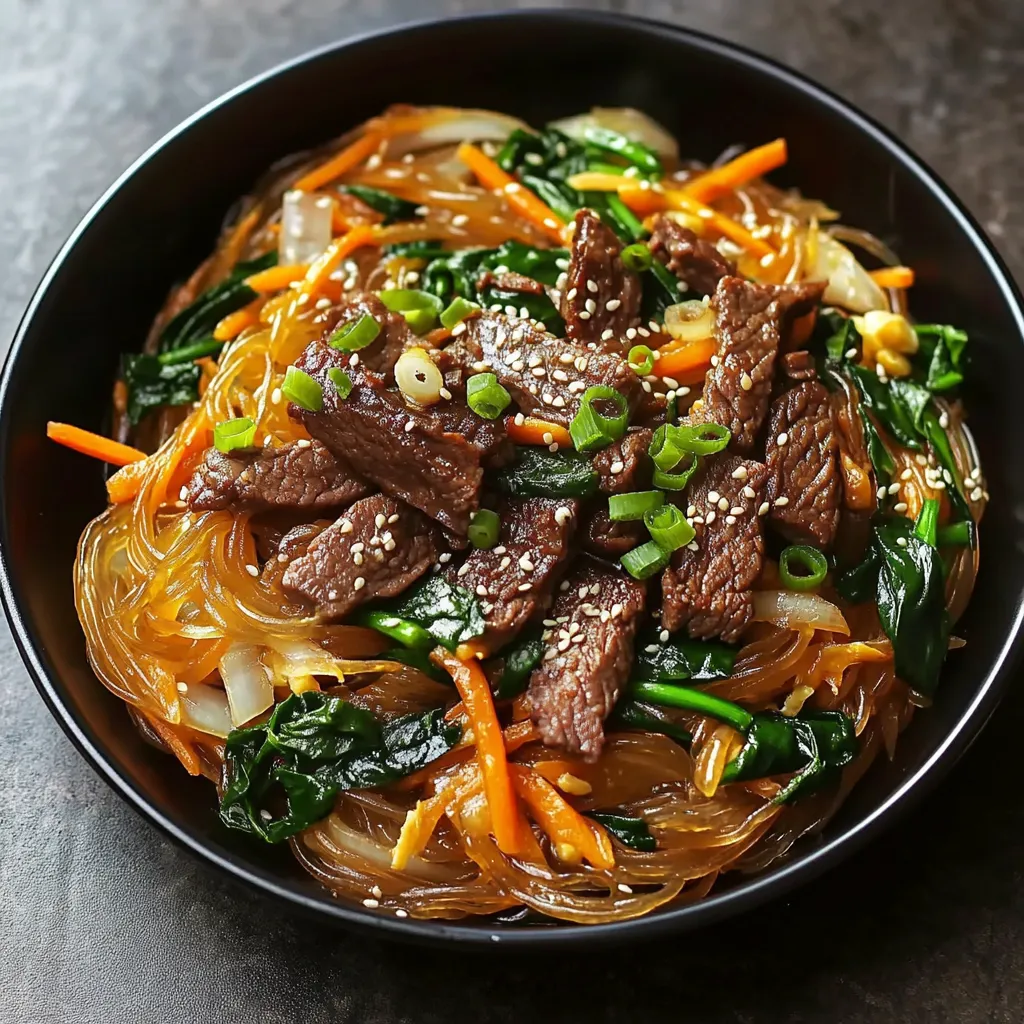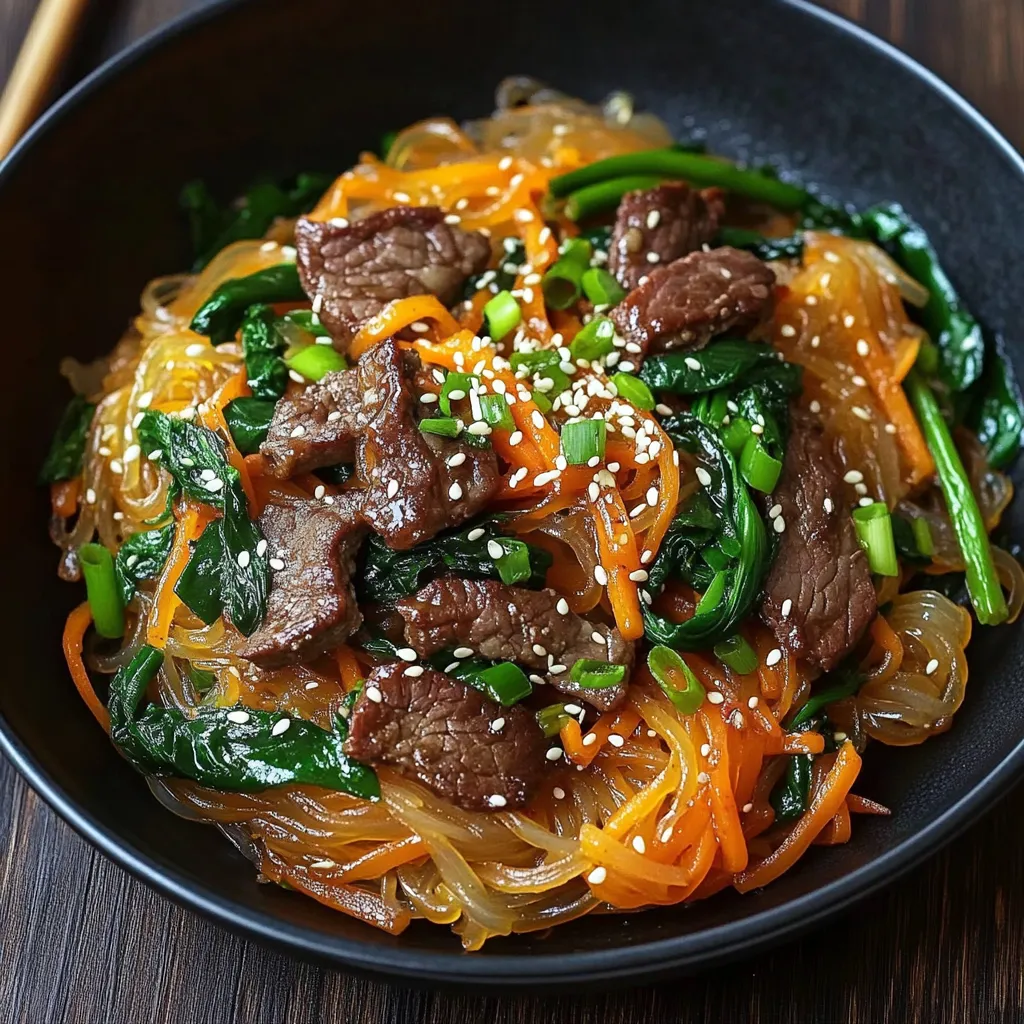 Pin it
Pin it
Japchae combines chewy sweet potato glass noodles with tender beef slices and vibrant vegetables in a harmonious blend that exemplifies the balanced nature of traditional Korean cuisine. This beloved dish features translucent noodles that glisten with a silky coating of sesame oil and soy sauce, absorbing the rich flavors while maintaining their distinctively springy texture that makes each bite satisfying. The colorful medley of carrots, spinach, mushrooms, and onions creates a visual feast that promises nutritional balance alongside remarkable taste. When finished with a sprinkle of toasted sesame seeds and fresh green onions, japchae delivers a multisensory experience that explains why this dish has remained a cornerstone of Korean celebrations and everyday meals alike for centuries, winning hearts across cultural boundaries with its approachable yet complex flavor profile.
I first encountered japchae during a cultural exchange program in college when my Korean roommate prepared it for our international food night. The moment I tasted those uniquely chewy noodles coated in savory sauce, I was captivated by how something so seemingly simple could deliver such remarkable texture and flavor harmony. Years later, after multiple attempts to recreate that memorable dish, I finally mastered the proper technique for preparing the glass noodles which transformed my homemade version from merely acceptable to authentically delicious.
Essential Ingredients
- Sweet Potato Glass Noodles: Form the foundation of this dish with their distinctive chewy texture and subtle sweetness.
- Sesame Oil: Provides the characteristic nutty aroma that defines Korean cuisine.
- Soy Sauce: Creates the savory base of the sauce that seasons every component.
- Beef Sirloin: Adds protein and rich flavor to the dish.
- Shiitake Mushrooms: Contribute earthy umami notes that complement the meat perfectly.
- Spinach: Provides vibrant color and nutritional benefits.
- Carrots: Add natural sweetness and vibrant orange color.
- Green Onions: Finish the dish with fresh, mild onion flavor.
- Garlic: Enhances the savory elements of the dish with aromatic depth.
- Brown Sugar: Balances the saltiness of the soy sauce with subtle sweetness.
- Neutral Cooking Oil: Ensures even stir frying without overpowering the flavors.
- Toasted Sesame Seeds: Add textural contrast and an additional nutty flavor in the final garnish.
- Fresh Ginger: Provides warmth and depth to the sauce mixture.
Preparation Process
- Prepare The Noodles
- Cook sweet potato glass noodles until translucent and chewy, then rinse under cold water and toss with sesame oil.
- Season The Protein
- Marinate beef sirloin with soy sauce, sugar, sesame oil, and garlic, allowing flavors to infuse.
- Prepare The Vegetables
- Julienne carrots, blanch spinach, slice onions and mushrooms, and separate green onion parts.
- Create The Sauce
- Whisk together soy sauce, brown sugar, sesame oil, garlic, and ginger until smooth.
- Cook Each Component
- Stir fry beef, then separately cook onions, carrots, mushrooms, and white parts of green onions.
- Combine All Elements
- Toss cooked noodles with sauce, then mix with beef and vegetables until well combined.
- Final Seasoning
- Add reserved green onions and toasted sesame seeds for freshness and crunch.
- Rest Before Serving
- Let japchae sit for five minutes to allow flavors to meld before serving warm or chilled.
 Pin it
Pin it
My Korean cooking instructor emphasized the importance of balancing five colors in traditional dishes, explaining how japchae exemplifies this philosophy with its colorful vegetables representing different nutritional benefits alongside symbolic meaning.
Serving Suggestions
Serve warm with steamed rice and kimchi for a traditional Korean meal or enjoy chilled with a cucumber and radish garnish for a refreshing side dish.
Creative Adaptations
Swap beef for chicken or shrimp, use extra mushrooms for a vegetarian version, or incorporate spicy gochujang for a bold twist.
Storage Wisdom
Store in an airtight container for up to four days, reheating with a splash of water to revive the noodles before serving.
 Pin it
Pin it
Japchae embodies the essence of Korean cuisine by balancing texture, color, and flavor, making it a beloved dish for celebrations and casual meals alike.
Frequently Asked Questions
- → Where can I find Korean sweet potato noodles?
- Korean sweet potato noodles (dangmyeon) are available at most Asian grocery stores, particularly Korean markets. They're usually sold in packages labeled as 'sweet potato starch noodles' or 'glass noodles.' If you don't have an Asian market nearby, you can also find them online through retailers like Amazon or specialty Asian food websites.
- → Can I make Japchae vegetarian or vegan?
- Absolutely! To make vegetarian Japchae, simply omit the beef and add more vegetables like shiitake mushrooms, bell peppers, or zucchini for extra texture and flavor. For a vegan version, ensure your soy sauce doesn't contain fish extracts (most tamari is safe). The dish is just as delicious and authentic without meat.
- → How far in advance can I prepare Japchae?
- Japchae actually tastes even better the next day after the flavors have had time to meld. You can prepare it up to 2-3 days in advance and store it in an airtight container in the refrigerator. Just bring it to room temperature before serving or gently reheat it. This makes it perfect for meal prep or when planning for parties.
- → What's the best cut of beef to use for Japchae?
- Ribeye or sirloin work best for Japchae as they remain tender when quickly stir-fried. Look for well-marbled pieces and slice them very thinly against the grain. For easier slicing, partially freeze the beef for about 30 minutes before cutting. If beef isn't available, you can substitute with pork, chicken thighs, or even shrimp.
- → Why are my sweet potato noodles clumping together?
- Noodles clump when they cool down without enough oil coating them. After boiling, drain and rinse them with cold water, then immediately toss with a tablespoon of sesame oil while they're still warm. Don't overcook them either - they should be chewy but not mushy. If they're already clumped, gently reheat them with a splash of water.
- → Is Japchae typically served hot or cold?
- Japchae is traditionally served at room temperature or just slightly warm, not piping hot. This allows the flavors to fully develop and the textures to shine. It's perfectly acceptable to serve it cold from the refrigerator as well, especially in summer months. This flexibility makes it an excellent choice for potlucks and picnics.
